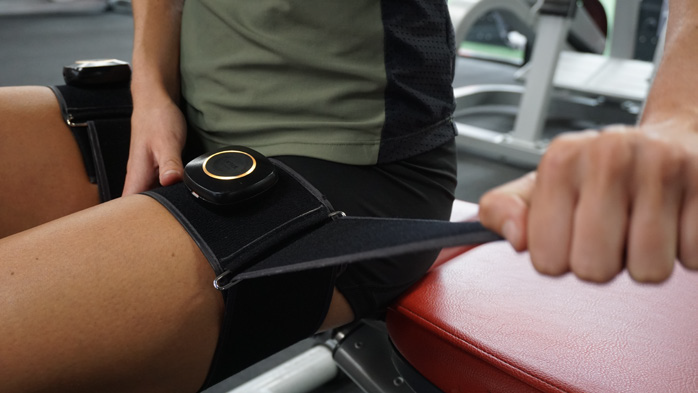Introduction to Blood Flow Restriction Training
Blood Flow Restriction Training (sometimes referred to as “Occlusion Training”), is a form of exercise used by health and fitness professionals to promote hypertrophy (muscle growth) and other beneficial physiological effects both for rehabilitation and for general health.
Our Physiotherapist, Reece Noble, has been using Blood Flow Restriction Training (BFRT) for a number of years now, and sees it as a powerful tool in his rehab arsenal. This blog is adapted from a previous article Reece wrote after a deep dive into the evidence behind BFRT (The full article can be found here).
Whilst BFRT has risen in popularity and become more mainstream in the past 5-10 years, it has been around for over 50 years since it’s inception by Dr Yoshiaki Sato.

BFRT works by applying a pneumonic (air filled) cuff to a person’s upper arm or leg and then exercising lightly with that limb. The effect of this is it alters the blood flow out of the limb, which causes blood and other exercise induced metabolites to pool in the limb.
This, quite amazingly, tricks your body into thinking it is working a whole lot harder than it actually is, which inturn stimulates muscle growth.
What can BFRT be used for?
BFRT can be used for almost any musculoskeletal condition. It is mostly used in instances where a limb, joint or muscle can’t handle heavy loads, but would benefit from getting stronger, examples of this are;
- Following an operation
- Sports injury recovery
- Recovering from a fracture – traumatic or stress related
- Osteoarthritis
On top of inducing hypertrophy, it has a number of other health benefits including (but not limited to);
- Cardiac rehabilitation
- Reducing the risk of blood clots
- Improving vascular health
- Increased VO2 max – particularly in elderly populations
BFRT vs High Load (heavy) Strength Training vs Low Load (light) Strength Training
When comparing and contrasting these 3 forms of strength training, specifically their effect on muscular size and strength, the most important pros and cons of each are
| Form | Pros | Cons |
| BFRT | Does not require high loads Can be utilised in compromised or healing joints and tissues Utilised metabolic stress pathways rather than mechanical – so can be used more regularly Benefit occur quicker than High load (2 vs 6 weeks) | Doesn’t give high mechanical load for bone and tendon healing Less stimulation of nervous system – low effect on power |
| High Load | Build strength at 1.3-1.6 x greater rate than BFRT over long term High nervous system stimulation so beneficial for power | Cannot be utilised with compromised tissues and joints |
| Low Load | Almost none in context of building muscle and strength | Loads not high enough to induce hypertrophy |
BFRT and aerobic exercise
Interestingly, BFRT can be used during traditionally aerobic exercise (e.g. stationary bike or walking on a treadmill). It is a great treatment modality for people who are deconditioned and struggle with any form of resistance training, people with arthritis and is also increasingly being used as a tool in cardiac rehabilitation.
The main benefit of adding BFR to aerobic exercises is it helps to stimulate hypertrophy when traditional aerobic exercise would not.

What does a session of BFRT involve?
- Safety Checks
- As with any health care or fitness intervention we make sure it is safe to you to perform BFRT
- Worth noting here – BFRT is just as safe as regular resistance training – i.e. very safe!
- Determine cuff pressure
- We use a % of your Arterial Occlusion Pressure (AOP)
- Your AOP is the pressure it takes to completely stop blood flowing through your arteries
- Our BFR cuffs find AOP automatically
- Maximum AOP we use is 50% for arms and 80% for legs
- Working pressure will often be less tan this and work up as an exercise progression
- Commence exercise with cuff inflated
- Resistance training with BFR
- Load 30% of 1 rep max (1RM) or less
- Generally a rep pattern of 30/15/15/15 (30 seconds break between sets) or to failure
- Aerobic Exercise
- Use very low pressure 20-23% of AOP as starting point
- Begin with short time performing exercise (5 minutes)
- Progress both time and % of AOP in subsequent session in response to session tolerance
Safety considerations (and a note on blood clots)
As mentioned above, BFRT is just as safe as any other form of resistance training exercise if done correctly.
The most common safety question I get asked is “does BFRT increase the risk of blood clots?” and the answer, no, it does not – unless there is already known blood clots including recent or ongoing DVT.
Infact, a 2007 paper by Nakajima et al – showed that it is most likely that BFRT is protective against blood clots through the release of a protein called Tissue Plasminogen Activator (tPA), particularly in healthy subjects.
Other conditions that will most likely rule a person out from BFRT are
- Unstable cardiac disease
- Severe varicose veins
- Pregnancy
- Active infection
- Open or healing wounds
Is Blood Flow Restriction Training right for you?
BFRT can be an integral part of almost any rehabilitation or health/fitness program. To evaluate if it is right for you it is best to consult with a trusted health or fitness professional that is trained in BFRT
Some important questions to consider are;
- Do I have any health conditions that would rule me out from using BFR? (see list above)
- Do I have a condition or would my health benefit from building more muscle? (hot tip – the answer to this is ALWAYS yes – having more muscle mass is beneficial to anyone’s health and is an often undervalued and underrated part of being health – particularly as we age)
- Do I have a joint or limb that would benefit from being stronger – but currently is unable to handle heavy loads?
What now?
If you have any further questions about BFRT or want to jump in and use BFRT as part of your rehab, please reach out to Reece via email at [email protected]
References
A full list of the references used for this blog can be found on the article it has been adapted from (also written by Reece Noble) CLICK HERE
About the author
Reece Noble is one of our senior Physiotherapists at Rehab Lab Studio, he also works at our partner clinic Bellarine Sports Medicine Clinic in Drysdale.
Reece has worked in private clinics in Melbourne, London and Geelong for the past 11 years, he has also been the physio for football, netball and cricket teams.
On top of his Physiotherapy Undergraduate Degree, Reece also holds a Masters Degree in Strength & Conditioning.

